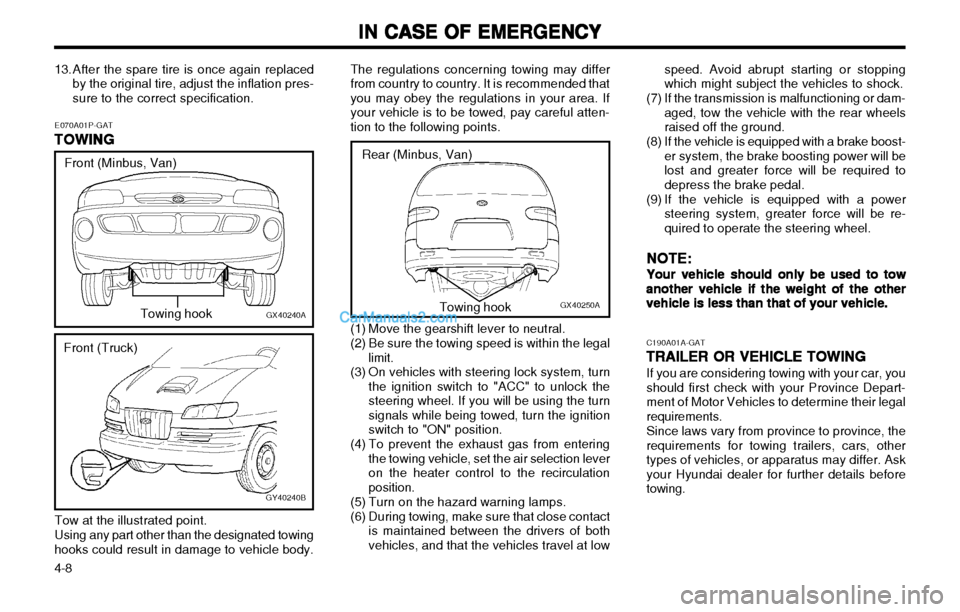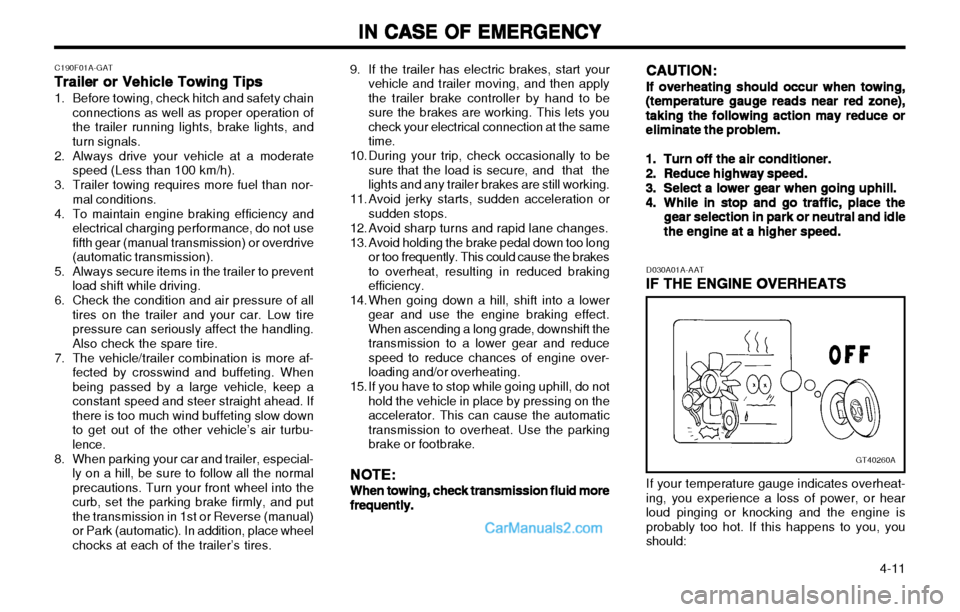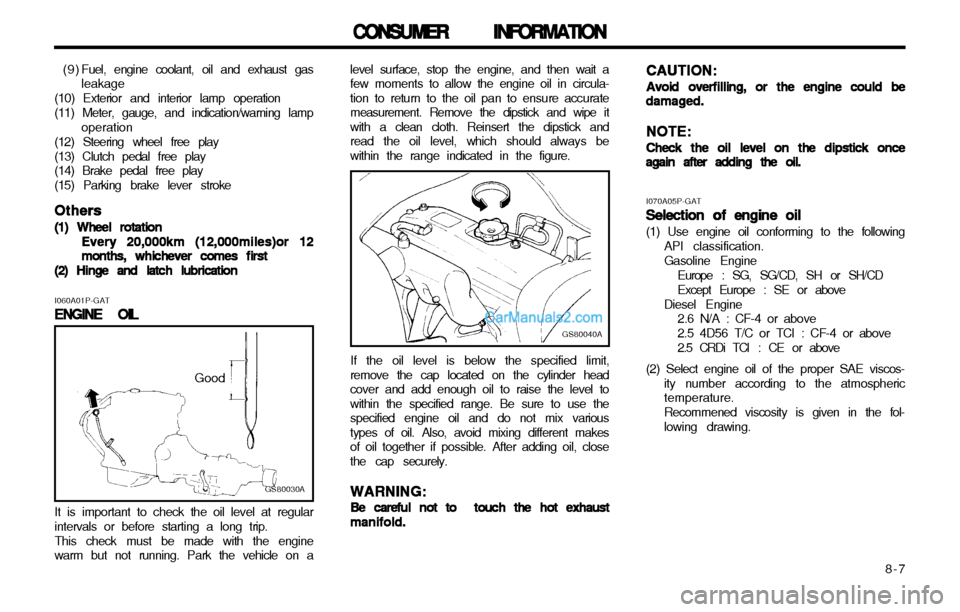2003 Hyundai H-1 (Grand Starex) stop start
[x] Cancel search: stop startPage 123 of 173

IN CASE OF EMERGENCY
IN CASE OF EMERGENCY IN CASE OF EMERGENCY
IN CASE OF EMERGENCY
IN CASE OF EMERGENCY
4-8 The regulations concerning towing may differ from country to country. It is recommended thatyou may obey the regulations in your area. Ifyour vehicle is to be towed, pay careful atten-tion to the following points.
C190A01A-GATTRAILER OR VEHICLE TOWING
TRAILER OR VEHICLE TOWING TRAILER OR VEHICLE TOWING
TRAILER OR VEHICLE TOWING
TRAILER OR VEHICLE TOWING
If you are considering towing with your car, youshould first check with your Province Depart-ment of Motor Vehicles to determine their legal requirements.Since laws vary from province to province, the requirements for towing trailers, cars, othertypes of vehicles, or apparatus may differ. Askyour Hyundai dealer for further details beforetowing.
GX40250A
Rear (Minbus, Van)Towing hook
(1) Move the gearshift lever to neutral.
(2) Be sure the towing speed is within the legal limit.
(3) On vehicles with steering lock system, turn the ignition switch to "ACC" to unlock the steering wheel. If you will be using the turnsignals while being towed, turn the ignitionswitch to "ON" position.
(4) To prevent the exhaust gas from entering the towing vehicle, set the air selection leveron the heater control to the recirculationposition.
(5) Turn on the hazard warning lamps.
(6) During towing, make sure that close contact is maintained between the drivers of both vehicles, and that the vehicles travel at low speed. Avoid abrupt starting or stoppingwhich might subject the vehicles to shock.
(7) If the transmission is malfunctioning or dam- aged, tow the vehicle with the rear wheelsraised off the ground.
(8) If the vehicle is equipped with a brake boost- er system, the brake boosting power will belost and greater force will be required todepress the brake pedal.
(9) If the vehicle is equipped with a power steering system, greater force will be re-quired to operate the steering wheel.
NOTE:
NOTE: NOTE:
NOTE:
NOTE:
Your vehicle should only be used to tow
Your vehicle should only be used to tow Your vehicle should only be used to tow
Your vehicle should only be used to tow
Your vehicle should only be used to tow another vehicle if the weight of the other
another vehicle if the weight of the other another vehicle if the weight of the other
another vehicle if the weight of the other
another vehicle if the weight of the other
vehicle is less than that of your vehicle.
vehicle is less than that of your vehicle. vehicle is less than that of your vehicle.
vehicle is less than that of your vehicle.
vehicle is less than that of your vehicle.
E070A01P-GAT
TOWING
TOWING TOWING
TOWING
TOWING
GX40240A
Front (Minbus, Van)
Towing hook
Tow at the illustrated point. Using any part other than the designated towing
hooks could result in damage to vehicle body.
GY40240B
Front (Truck)
13. After the spare tire is once again replaced
by the original tire, adjust the inflation pres- sure to the correct specification.
Page 126 of 173

IN CASE OF EMERGENCY
IN CASE OF EMERGENCY IN CASE OF EMERGENCY
IN CASE OF EMERGENCY
IN CASE OF EMERGENCY
4-11
9. If the trailer has electric brakes, start your
vehicle and trailer moving, and then apply the trailer brake controller by hand to besure the brakes are working. This lets you
check your electrical connection at the sametime.
10. During your trip, check occasionally to be sure that the load is secure, and that thelights and any trailer brakes are still working.
11. Avoid jerky starts, sudden acceleration or sudden stops.
12. Avoid sharp turns and rapid lane changes.
13. Avoid holding the brake pedal down too long or too frequently. This could cause the brakes to overheat, resulting in reduced brakingefficiency.
14. When going down a hill, shift into a lower gear and use the engine braking effect.When ascending a long grade, downshift the
transmission to a lower gear and reducespeed to reduce chances of engine over-
loading and/or overheating.
15. If you have to stop while going uphill, do not hold the vehicle in place by pressing on theaccelerator. This can cause the automatictransmission to overheat. Use the parkingbrake or footbrake.
NOTE:
NOTE: NOTE:
NOTE:
NOTE:
When towing, check transmission fluid more
When towing, check transmission fluid more When towing, check transmission fluid more
When towing, check transmission fluid more
When towing, check transmission fluid more frequently.
frequently. frequently.
frequently.
frequently. CAUTION:
CAUTION: CAUTION:
CAUTION:
CAUTION:
If overheating should occur when towing,
If overheating should occur when towing, If overheating should occur when towing,
If overheating should occur when towing,
If overheating should occur when towing,(temperature gauge
(temperature gauge (temperature gauge
(temperature gauge
(temperature gauge
reads near red zone),
reads near red zone), reads near red zone),
reads near red zone),
reads near red zone),
taking the following action may reduce or
taking the following action may reduce or taking the following action may reduce or
taking the following action may reduce or
taking the following action may reduce or
eliminate
eliminate eliminate
eliminate
eliminate
the problem.
the problem. the problem.
the problem.
the problem.
1.1.
1.1.
1. Turn off the air conditioner.
Turn off the air conditioner. Turn off the air conditioner.
Turn off the air conditioner.
Turn off the air conditioner.
2.2.
2.2.
2. Reduce highway speed.
Reduce highway speed. Reduce highway speed.
Reduce highway speed.
Reduce highway speed.
3.3.
3.3.
3. Select a lower gear when going uphill.
Select a lower gear when going uphill. Select a lower gear when going uphill.
Select a lower gear when going uphill.
Select a lower gear when going uphill.
4.4.
4.4.
4. While in stop and go traffic, place the
While in stop and go traffic, place the While in stop and go traffic, place the
While in stop and go traffic, place the
While in stop and go traffic, place the
gear selection in park
gear selection in park gear selection in park
gear selection in park
gear selection in park or neutral and idle
or neutral and idle or neutral and idle
or neutral and idle
or neutral and idle
the engine at a higher speed.
the engine at a higher speed. the engine at a higher speed.
the engine at a higher speed.
the engine at a higher speed.
C190F01A-GAT
Trailer or Vehicle Towing Tips
Trailer or Vehicle Towing Tips Trailer or Vehicle Towing Tips
Trailer or Vehicle Towing Tips
Trailer or Vehicle Towing Tips
1. Before towing, check hitch and safety chain
connections as well as proper operation of the trailer running lights, brake lights, andturn signals.
2. Always drive your vehicle at a moderate speed (Less than 100 km/h).
3. Trailer towing requires more fuel than nor- mal conditions.
4. To maintain engine braking efficiency and electrical charging performance, do not usefifth gear (manual transmission) or overdrive(automatic transmission).
5. Always secure items in the trailer to prevent load shift while driving.
6. Check the condition and air pressure of all tires on the trailer and your car. Low tirepressure can seriously affect the handling.
Also check the spare tire.
7. The vehicle/trailer combination is more af- fected by crosswind and buffeting. Whenbeing passed by a large vehicle, keep aconstant speed and steer straight ahead. Ifthere is too much wind buffeting slow downto get out of the other vehicle’s air turbu-lence.
8. When parking your car and trailer, especial- ly on a hill, be sure to follow all the normalprecautions. Turn your front wheel into the
curb, set the parking brake firmly, and putthe transmission in 1st or Reverse (manual)or Park (automatic). In addition, place wheel
chocks at each of the trailer’s tires. D030A01A-AAT
IF THE ENGINE OVERHEATS
IF THE ENGINE OVERHEATS IF THE ENGINE OVERHEATS
IF THE ENGINE OVERHEATS
IF THE ENGINE OVERHEATS
GT40260A
If your temperature gauge indicates overheat-
ing, you experience a loss of power, or hear loud pinging or knocking and the engine isprobably too hot. If this happens to you, youshould:
Page 156 of 173

8-7
CONSUMER INFORMATION
CONSUMER INFORMATION CONSUMER INFORMATION
CONSUMER INFORMATION
CONSUMER INFORMATION
( 9 ) Fuel, engine coolant, oil and exhaust gas leakage
(10) Exterior and interior lamp operation (11) Meter, gauge, and indication/warning lamp operation
(12) Steering wheel free play(13) Clutch pedal free play (14) Brake pedal free play (15) Parking brake lever stroke
Others
Others Others
Others
Others
(1) Wheel rotation
(1) Wheel rotation (1) Wheel rotation
(1) Wheel rotation
(1) Wheel rotation
Every 20,000km (12,000miles)or 12
Every 20,000km (12,000miles)or 12 Every 20,000km (12,000miles)or 12
Every 20,000km (12,000miles)or 12
Every 20,000km (12,000miles)or 12
months, whichever comes first
months, whichever comes first months, whichever comes first
months, whichever comes first
months, whichever comes first
(2) Hinge and latch lubrication
(2) Hinge and latch lubrication (2) Hinge and latch lubrication
(2) Hinge and latch lubrication
(2) Hinge and latch lubrication level surface, stop the engine, and then wait a few moments to allow the engine oil in circula-tion to return to the oil pan to ensure accuratemeasurement. Remove the dipstick and wipe itwith a clean cloth. Reinsert the dipstick andread the oil level, which should always bewithin the range indicated in the figure.
GS80030A
Good
I060A01P-GAT
ENGINE OIL
ENGINE OIL ENGINE OIL
ENGINE OIL
ENGINE OIL
It is important to check the oil level at regular
intervals or before starting a long trip.
This check must be made with the engine
warm but not running. Park the vehicle on a
GS80040A
If the oil level is below the specified limit,
remove the cap located on the cylinder head cover and add enough oil to raise the level towithin the specified range. Be sure to use thespecified engine oil and do not mix varioustypes of oil. Also, avoid mixing different makesof oil together if possible. After adding oil, closethe cap securely.
WARNING:
WARNING: WARNING:
WARNING:
WARNING:
Be careful not to touch the hot exhaust
Be careful not to touch the hot exhaust Be careful not to touch the hot exhaust
Be careful not to touch the hot exhaust
Be careful not to touch the hot exhaust manifold.
manifold. manifold.
manifold.
manifold. CAUTION:
CAUTION: CAUTION:
CAUTION:
CAUTION:
Avoid overfilling, or the engine could be
Avoid overfilling, or the engine could be Avoid overfilling, or the engine could be
Avoid overfilling, or the engine could be
Avoid overfilling, or the engine could bedamaged.
damaged. damaged.
damaged.
damaged.
NOTE:
NOTE: NOTE:
NOTE:
NOTE:
Check the oil level on the dipstick once
Check the oil level on the dipstick once Check the oil level on the dipstick once
Check the oil level on the dipstick once
Check the oil level on the dipstick onceagain after adding the oil.
again after adding the oil. again after adding the oil.
again after adding the oil.
again after adding the oil.
I070A05P-GATSelection of engine oil
Selection of engine oil Selection of engine oil
Selection of engine oil
Selection of engine oil (1) Use engine oil conforming to the following
API classification. Gasoline Engine
Europe : SG, SG/CD, SH or SH/CDExcept Europe : SE or above
Diesel Engine 2.6 N/A : CF-4 or above2.5 4D56 T/C or TCI : CF-4 or above
2.5 CRDi TCI : CE or above
(2) Select engine oil of the proper SAE viscos- ity number according to the atmospheric temperature. Recommened viscosity is given in the fol- lowing drawing.
Page 172 of 173

INDEX
INDEX INDEX
INDEX
INDEX
10-4 SPARE TIRE ANTI-THEFT DEVICE
.................................................... 4-5
SPARE WHEEL ............................................................................. 4 - 4 ~ 4 - 5
SPEEDOMETER ........................................................................................ 2-5
SRS AIRBAG SYSTEM ........................................................... 1-29 ~ 1-32
SRS (Airbag) SERVICE REMINDER INDICATOR ........................2-10
STARTING THE ENGINE ....................................................................... 3-2
STARTING AND STOPPING THE ENGINE FOR TURBO CHARGER OR TURBO CHARGER INTERCOOLER .................. 3-3
STEERING WHEEL FREE PLAY ......................................................8-13
STEERING WHEEL TILT LEVER ......................................................1-29
STEREO RADIO AND CASSETTE TAPE PLAYER OPERATION (K220) .............................................................. 2-33 ~ 2-36
STEREO RADIO AND CASSETTE TAPE PLAYER OPERATION (H240, K240) ..................................................2-37 ~ 2-40
STEREO RADIO AND CASSETTE TAPE AND COMPACT DISC
PLAYER OPERATION (H280) ............................................2-48 ~ 2-54
STEREO RADIO AND COMPACT DISC PLAYER
OPERATION (H260) .............................................................. 2-41 ~ 2-47
SUNROOF ................................................................................... 2-19 ~ 2-20
SUN SHADE ............................................................................................ 2-19
SUN VISOR .............................................................................................. 2-20
T TACHOMETER ........................................................................................... 2-5
TAILGATE WINDOW WASHER FLUID LEVEL .............................8-12
TAILGATE WIPER AND WASHER SWITCH .................................2-13
TAILGATE .................................................................................................... 1-9
THEFT-ALARM SYSTEM ........................................................ 1-10 ~ 1-11THERMOMETER
....................................................................................... 2-7
THIRD SEAT ............................................................................... 1-20 ~ 1-21
TIRE INFLATION PRESSURE ............................................................ 8-13
TOOLS AND JACK ................................................................................... 4-1
TOWING ....................................................................................................... 4-8
TRAILER OR VEHICLE TOWING ..........................................4-8 ~ 4-11
TRANSAXLE FLUID .................................................................................. 9-4
TURN-SIGNAL INDICATION LAMPS-GREEN .................................. 2-9
TURN-SIGNAL SWITCH ....................................................................... 2-11
TWIN SWING DOOR ............................................................................ 1-14
V VENTILATION .......................................................................................... 2-25
VEHICLE IDENTIFICATION NUMBER (VIN) ..................................... 1-2
W WATER TEMPERATURE GAUGE ....................................................... 2-6
WHEEL CONDITION ............................................................................. 8-12
WHEEL ROTATION ............................................................................... 8-15
WINDSHIELD WASHER FLUID LEVEL ...........................................8-12
WINDSHIELD WASHER ....................................................................... 2-12
WINDSHIELD WIPER AND WASHER SWITCH ...........................2-12